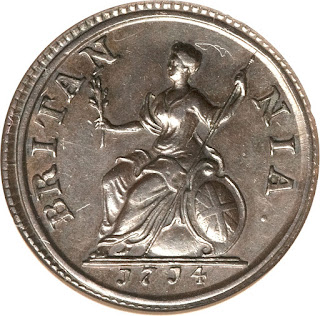British Coins Farthing 1714 Queen Anne
Anne Farthing 1714
The obverse features the draped bust of Queen Anne facing left. The inscription reads "ANNA DEI. GRATIA", Latin for "Anne By the Grace of God".
Reverse: The figure of Britannia seated, leaning on a shield which bears the combined crosses of St. George and St. Andrew; in her right hand she holds a palm-branch and in her left a spear, legend as follows: "BRITANNIA". The figure of Britannia is very graceful and beautifully executed, being the portrait of the beautiful Frances Teresa Stewart, Duchess of Richmond and Lennox (8 July 1647–15 October 1702).
The Britannia on the farthing now became more like that of the Roman coin, from which it was originally taken.
Country: United Kingdom.
Year: 1714.
Value: 1 Farthing.
Metal: Copper.
Weight: 5.79 g.
Diameter: 22 mm.
Shape: Round.
Demonetized: 12-31-1869.
References: KM# 537, Sp# 3625.
Coins of the United Kingdom - Farthings
Farthing 1714 Queen Anne Farthing 1823 King George IV Farthing 1831 King William IV
Anne, Queen of Great Britain
Anne (6 February 1665 – 1 August 1714) became Queen of England, Scotland and Ireland on 8 March 1702. On 1 May 1707, under the Acts of Union, two of her realms, the kingdoms of England and Scotland, united as a single sovereign state known as Great Britain. She continued to reign as Queen of Great Britain and Ireland until her death.
Anne was born in the reign of her uncle Charles II, who had no legitimate children. Her father, James, was first in line to the throne. His suspected Roman Catholicism was unpopular in England, and on Charles's instructions Anne was raised as an Anglican. Three years after he succeeded Charles, James was deposed in the "Glorious Revolution" of 1688. Anne's Dutch Protestant brother-in-law and cousin William III became joint monarch with his wife, Anne's elder sister Mary II. Although the sisters had been close, disagreements over Anne's finances, status and choice of acquaintances arose shortly after Mary's accession and they became estranged. William and Mary had no children. After Mary's death in 1694, William continued as sole monarch until he was succeeded by Anne upon his death in 1702.
As queen, Anne favoured moderate Tory politicians, who were more likely to share her Anglican religious views than their opponents, the Whigs. The Whigs grew more powerful during the course of the War of the Spanish Succession, until in 1710 Anne dismissed many of them from office. Her close friendship with Sarah Churchill, Duchess of Marlborough, turned sour as the result of political differences.
Anne was plagued by ill health throughout her life. From her thirties onwards, she grew increasingly lame and obese. Despite seventeen pregnancies by her husband, Prince George of Denmark, she died without any surviving children and was the last monarch of the House of Stuart. Under the terms of the Act of Settlement 1701, she was succeeded by her second cousin George I of the House of Hanover, who was a descendant of the Stuarts through his maternal grandmother, Elizabeth, a daughter of James VI and I.
The figure of Britannia
The figure of Britannia is an integral feature of British coins. The personification of Britain by a female figure dates back to the Roman Emperors Hadrian (117-138 AD) and Antoninus Pius (138-161 AD), both of whom commemorated the achievements in Britain by striking coins featuring Britannia. She made her debut seated, resting her head on her right arm, while holding a spear in her left hand with her left arm resting on a shield and her right foot on a pile of rocks. For just over 1500 years, Britannia was lost to numismatics. However, she made her reappearance during the reign of Charles II, first on medals and then on the copper halfpennies and farthings.
Samuel Pepys even makes reference to the medal in his Diary. The entry for 25 February 1667 reads:
At my goldsmith’s did observe the King’s new meal, where, in little, there is Mrs (ie Mistress) Stuart’s face as well-done as ever I saw anything in my whole life, I think: and a pretty thing it is, that he should choose her face to represent Britannia by.

